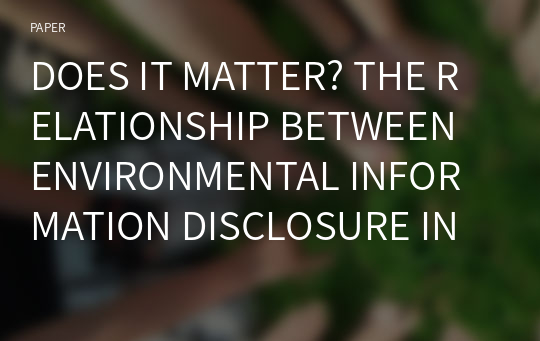DOES IT MATTER? THE RELATIONSHIP BETWEEN ENVIRONMENTAL INFORMATION DISCLOSURE IN ADVERTISING AND CONSUMER ETHICAL BEHAVIORS
* 본 문서는 배포용으로 복사 및 편집이 불가합니다.
서지정보
ㆍ발행기관 : 글로벌지식마케팅경영학회(GFMC)
ㆍ수록지정보 : Global Marketing Conference
ㆍ저자명 : Hsiu-Hua Chang
ㆍ저자명 : Hsiu-Hua Chang
영어 초록
IntroductionConsumer ethical behaviors regarding social impact, environmental concern, and ethical practices for the buyer/seller dyad has become a vital issue. A large number of consumers have the willingness to be activists to address potentially threatening environmental problems with foresight (Atkinson & Rosenthal, 2014). Consumers with environment awareness have begun to consider the environmental claims of products, such as environmental protection certification (do Paço & Reis, 2012) and production process with environmental protection regulations (Yoon & Kim, 2016). All such information effectively spreads the environmental protection knowledge to help consumers identify the environmental features of the product (Leonidou, Leonidou, Palihawadana, & Hultman, 2011), and then to conduct consumption behaviors with ethical/moral concerns. However, the related research to examine the relationships between consumer ethical behaviors and their attitudes toward environmental information disclosure in advertising in Asian countries is few. This study’s main purpose is thus to understand how environmental information disclosure in advertising influences consumers’ attitudes toward the brand and their ethical behaviors.
Literature Review
Mitchell, Balabanis, Schlegelmich, and CornWell (2009) argues that all direct or indirect consumer actions that could make businesses or other stakeholders to lose money or reputation are viewed as consumer unethical behaviors. Consumers’ (un)ethical behaviors would be influenced by their moral principles and standards as they obtain, use, and dispose of goods and services (Muncy & Vitell, 1992). First, according to the equity theory, brand equity will increase the relationship intention between sellers and buyers. Those consumers with a high perception about product value or brand equity would tend to build a positive relationship with sellers, and thus their ethical behaviors would be influenced (Chang & Lu, 2017). Consumers’ ethical consumption depends on the equity of the profitability of the seller and this study proposes that brand equity has significant positive effects on consumer ethical behavior (H1). Second, environmental advertising claims refer to the classification of environmental claims in advertising with various environmental protection information about products (do Paço & Reis, 2012). Chan, Leung, and Wong (2006) state the two types of environmental advertising claims. Substantial environmental claims focus on the substantial benefits of products for the environment and the positive impacts of enterprises on the environment in order to substantially maintain or enhance consumers’ understanding of products with environmental awareness (Chan, 2000). Associated environmental claims feature advertising that do not have a direct connection with the products or production of enterprises; instead, they reveal an enterprises’ concern about environmental protection topics through environmental protection activities or topics regarding the conservation of the ecosystem, in order to indirectly trigger the consumers’ positive image and reactions to the enterprises or brands (Chan, 2000). Different environmental advertising claims would have different extents of impact on consumers’ attitude towards advertising and the product (Chan et al., 2006). Chan (2000) states that substantial environmental claims are more persuasive than associated claims, as the advertising of the former could directly publicize the specific environmentally-friendly measures in products or production process. The hypotheses are thus submitted: environmental advertising claims have significant positive effects on brand equity (H2.) and the impact power of substantial environmental claims on brand equity is stronger than those of associated environmental claims (H3). Third, eco-labels provide the information of products toward the environment influence during their life cycles (Atkinson & Rosenthal, 2014; Chekima, Wafa, Igau, Chekima, & Sondoh, 2016) and the claims regarding the eco-features, production, and constituents of the products (Atkinson & Rosenthal, 2014). Maniatis (2016) argues that eco-labels could clearly reveal the economic and ecological benefits of products and help consumers make purchase decisions. Specific claims, such as marks, pictures, or signs, could clearly convey information about the products, which make it easy for consumers to understand. Therefore, hypothesis 4 is submitted: environmental advertising with eco-labels has a significant positive effect on brand equity (H4).
Method
This study used the 2x2 factor experiment to create four situations through two types of environmental advertising claims (substantial and associated environmental advertising claims) and two types of eco-labels (available/unavailable). The manipulation checks with regards to the constructs of environmental advertising claims and eco-label were shown to be successful through a pilot test. On the other hand, this study selected 14-items of Muncy and Vitell’s (1992) scale to measure consumer ethical behaviors. The measuring items of brand equity were taken by Yoo and Donth’s (2001) three-dimensional scale, containing brand awareness/associations, perceived quality, and brand loyalty. Moreover, 294 valid questionnaires were retained in the formal survey via electronic questionnaire survey. Females accounted for 50.7%. Those aged less than 25 occupied a larger proportion (50%), followed by those aged from 26 to 35 (21.8%). The samples with a college education or above accounted for 92.5%. Additionally, the component reliability, convergent and discriminant validity were also confirmed (Bagozzi & Yi, 1988; Fornell & Larcker, 1981) due to the results of confirmatory factor analysis (CFA) by Lisrel 8.7.
Results and Conclusion
Based on the ANOVA results, first, environmental advertising claims had significant effects on awareness/association, perceived value, and loyalty. The effects of substantial orientation on brand equity were significantly stronger than that of associated orientation claims. H2 and H3 were fully supported. That is to say, substantial environmental advertising claims could reveal enterprise efforts to protect the environment and inform consumers that the substantial benefits for the ecosystem are embodied in their products. If enterprises want to disclose information about their social responsibility or to convey the contribution of their products toward environmental protection, direct environmental advertising claims related to product features and production processes should be considered. Second, eco-labels significantly affected on awareness/association, perceived value, and loyalty; hence, H4 were supported. Eco-labels verified by a third-party public notary office could enhance brand equity. As eco-label information regarding environmental protection enterprises and products want to convey, consumers can comprehend and evaluate such environmental advertising through the mark of eco-labels in triggering their positive attitude and value toward the brand. Third, this study also found that the interactive effect of environmental advertising claims and eco-label on the awareness/association dimension of brand equity was significant. Consumers are more likely to receive information from the environmental advertising with a substantial claim and eco-label than other sets, and then their perceptions toward that brand awareness and brand association could be improved. Forth, each dimension of awareness/association, perceived value, and brand loyalty had a significant positive effect on consumer’s ethical behaviors by using structural equation modeling (SEM) via Lisrel 8.7; H1 therefore were supported. That is, consumers’ perceived enterprise efforts related to protecting the environment would improve consumers’ ethical behaviors. If advertising could fully and effectively convey the environmental protection information embodied in products, consumers would know that the products are beneficial for society and ecosystems, and thus they would enact ethical activities in the marketplace. Finally, future studies can use random sampling to improve the sample representative. Product type can also be included into the research model in future studies to consider the different product features how to influence the effects of environmental advertising claims and eco-labels on the consumers’ attitudes and behavior decision.
참고 자료
없음태그
"Global Marketing Conference"의 다른 논문
 THE ROLES OF GREEN PACKAGING IN UGLY FOOD PURCHASE INTE..22페이지
THE ROLES OF GREEN PACKAGING IN UGLY FOOD PURCHASE INTE..22페이지 THE IMPACT OF INDUCED AWE ON ETHICAL TOURIST BEHAVIORS5페이지
THE IMPACT OF INDUCED AWE ON ETHICAL TOURIST BEHAVIORS5페이지 A BIBLIOMETRIC ANALYSIS OF SPIRITUAL TOURISM RESEARCH15페이지
A BIBLIOMETRIC ANALYSIS OF SPIRITUAL TOURISM RESEARCH15페이지 SOCIAL NETWORK ANALYSIS AND RESPONSE TIME TESTING: CONS..11페이지
SOCIAL NETWORK ANALYSIS AND RESPONSE TIME TESTING: CONS..11페이지 THE EFFECTS OF PARA-SOCIAL INTERACTION ON ONLINE CELEBR..3페이지
THE EFFECTS OF PARA-SOCIAL INTERACTION ON ONLINE CELEBR..3페이지 THE INFLUENCE OF OPINION LEADERS ON DAILY DEALS USER’S ..3페이지
THE INFLUENCE OF OPINION LEADERS ON DAILY DEALS USER’S ..3페이지 HOW IMMERSIVE RETAILING AFFECTS CONSUMERS’ URGE TO BUY:..6페이지
HOW IMMERSIVE RETAILING AFFECTS CONSUMERS’ URGE TO BUY:..6페이지 KEY TO SUPERSTARDOM IN A GLOBALISED MARKET: THE ROLE OF..6페이지
KEY TO SUPERSTARDOM IN A GLOBALISED MARKET: THE ROLE OF..6페이지 A POST-PANDEMIC LOOK AT TOURISTS’ PERCEIVED COOLNESS OF..4페이지
A POST-PANDEMIC LOOK AT TOURISTS’ PERCEIVED COOLNESS OF..4페이지 EXTRACTING OFFLINE RETAIL SHOPPING PATTERNS: OLLABORATI..5페이지
EXTRACTING OFFLINE RETAIL SHOPPING PATTERNS: OLLABORATI..5페이지

























